This was published 1 year ago
Bangkok, travel guide and things to do around Chao Phraya river: It's Bangkok, just not as you know it
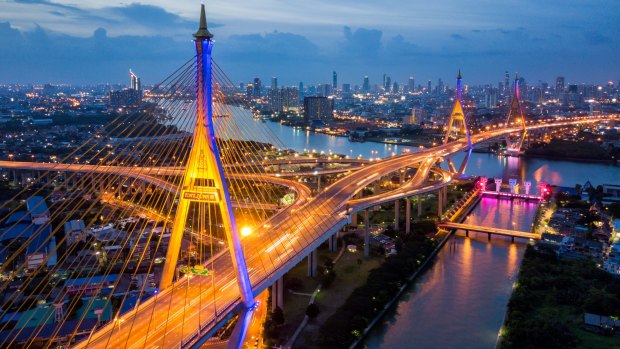
Bangkok has become a hip, happening, cultural city.Credit: Getty Images
It's become a lot cooler by the river in Bangkok since we've been gone. I don't mean that the Chao Phraya - that slinking equatorial cocoa-coloured serpent that curls through this city of almost 11 million like a grand aquatic superhighway - is the place to escape the enervating heat.
Bangkok, after all, is officially the world's fourth hottest capital and a miracle cool breeze wafting up from the Gulf of Thailand is as rare here as a toned-down street hawker's tom yum goong.
No, what I mean is that Bangkok has become cool in another sense entirely. Hip. Happening. Arty. It's the sort of culturally-driven coolness that could go a long way to transforming its at times seedy international image.
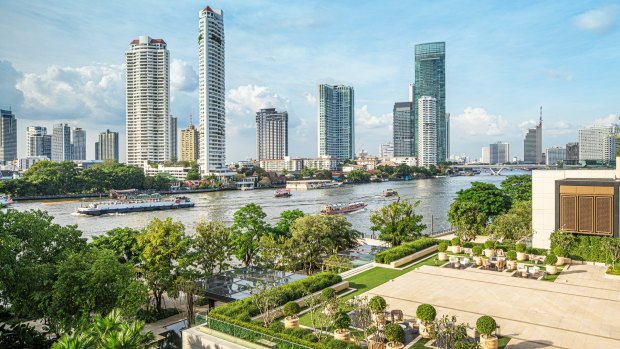
Four Seasons Bangkok.
And this is largely all occurring right beside the river, still lined with teetering, ramshackle teak houses and towered over by eclectic religious pagodas, steeples and minarets. These homes, many now converted into restaurants, cafes and bars, seem poised at any moment to tip into the river full of circling cat-fish, absurdly plump from their diets of the unspeakable contents of the notoriously befouled Chao Phraya.
Without schools of tourists - thanks to the pandemic - to clog the wonderfully haphazard, overstuffed and unplanned streets and alleys of riverside Talat Noi and Bang Rak neighbourhoods, Bangkokians, many of them young, have been drawn back to the river by an an incipient art scene and a host of sparkling new developments.
Here, focused in and around the somewhat prosaically-dubbed Creative District and well within view of the waterway, the visitor will encounter a burgeoning number of art galleries, eateries, bars and what is now the epicentre of Bangkok's vibrant street art movement.
Soon enough, as the tourists trickle back, the river proper will return to something approaching the appealing chaos that has always characterised it and made me love it.
Meanwhile for visitors like me there's still considerable life to be found on its banks. Come with me as we explore this surprising and compelling side of Bangkok, at all times sticking close to the banks of the royal Chao Phraya, the "River of Kings".
TAKE ME (BACK) TO THE RIVER
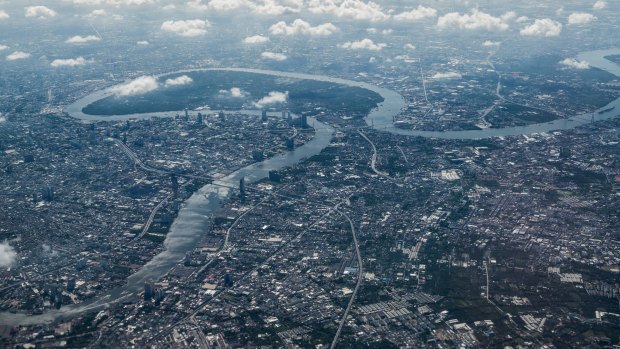
The Chao Phraya winds its way through Bangkok.Credit: Getty Images
One of the most enthusiastic advocates for the Chao Phraya and its cultural tourism is David Robinson, an expat Australian who curates bangkokriver.com, an essential online guide championing the underrated allures of the Chao Phraya and the businesses which operate on and beside it.
"For better or worse, Bangkok has become known as a destination for shopping, nightlife and massage," Robinson says. "Precincts like Ratchaprasong, Sukhumvit, Chatuchak Market, and Patpong offer the traveller instant gratification. But for those seeking out the real Bangkok, the Chao Phraya is the place to base yourself and explore. People of all walks and backgrounds have gravitated to the area to open galleries, restaurants, small offices and the like."
The reality, though, is that the Thai capital has suffered a near lethal Thai kick boxing-style straight foot jab direct to its economic solar plexus thanks to COVID, with tourism the biggest casualty. I'm among the first foreign visitors to return to the once frenetic Thai capital and, frankly, I barely recognise it.
Bangkok's fleet of restaurant boats, gaudily lit in neon by night remain deathly idle, tethered to jetties awaiting the return of foreign tourists. And the long-tails, the Chao Phraya's most distinctive watercraft propelled by crudely though cleverly-adapted thunderous car engines, are conspicuous by their absence.
The seasonal clumps of pesky water hyacinth that float down the Chao Phraya are missing, too, during this visit though the procession of unlovely, multiple grey cargo barges, dragged along by straining tugs to and from the port, continues largely unabated.
With the bulk of overseas visitors - notably the big-spending Chinese and Russians - yet to return, the Chao Phraya, with a total length of 372 kilometres, is in the midst of an extended and utterly unfamiliar hiatus.
Even the traffic jams, which will never go away, seem less severe, meaning you get trapped in them for an hour rather than the previous requisite two or three. There's always the ever-expanding, gridlock-beating BTS Skytrain, the elevated rapid transit system, and a two, soon to be three-line underground railway.
"The pandemic hit Bangkok hard," says Robinson. "International tourism virtually stopped from one day to the next. For two years businesses dependent on foreign visitors struggled. However, with people unable to travel, it proved to be a wonderful time for people locked in Thailand to explore the country."
As a result, thousands flocked to the Creative District and Talat Noi to explore their own backyard. It's also been a time when businesses have been transformed by young and passionate entrepreneurs, many who have spent time abroad, including in Australia. Importantly, says Robinson, there's "an appreciation of the past in the creation of the new present".
A LITTLE BIT ON THE RIVERSIDE
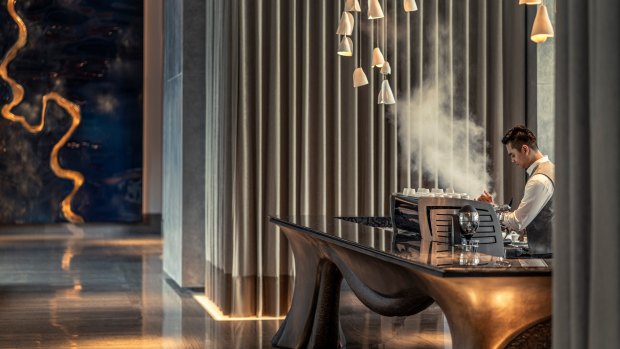
My visit begins with a nasal swab (no longer required) taken in style in a hotel limo at a hospital after I'm picked up at the airport. I'm then transported to the elegant 299-room Four Seasons Bangkok at Chao Phraya River where I'm staying for several nights..This five-star hotel opened in December, 2020, making and is one of the latest five stars along the waterway. It's set to deliver some formidable competition to the other more established luxury hotels beside the river.
The previous Four Seasons Bangkok was in the centre of town near Lumphini Park, bustling Bangkok's green public lung. This was well away from the Chao Phraya. But in a telling indication of the strength of the river's revival, Four Seasons committed to locating its new luxury hotel-cum-urban-resort right beside it, after noting that guests were keen to be close to the waterway.
"The river really is the heartbeat of Bangkok, and more and more locals and tourists are coming down to the river to explore the culture, both new and old, in the area," says Czech-born Lubosh Barta, general manager of Four Seasons Bangkok at Chao Phraya River.
"Additionally, the development of the Creative District is a great opportunity for our guests to connect with the new, young side of Bangkok, while still having easy access to all the great Bangkok attractions."
So eager is the hotel to connect with this area that it's staging "POV: Streets of BKK", an exhibition of Bangkok street art, held in conjunction with the city's Museum of Contemporary Art, within ART Space, the hotel's own sizeable gallery. It will run until the end of July.
INTO THE ART OF BANGKOK
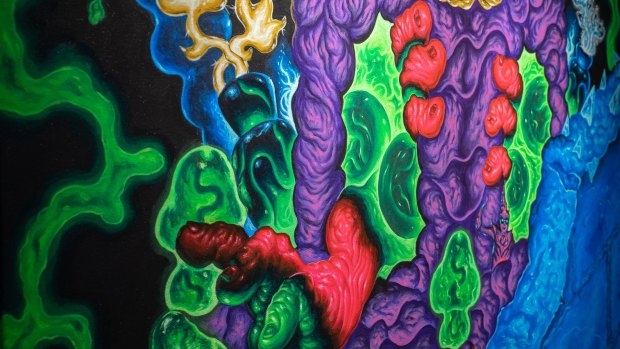
Guests at the Four Seasons can book and take a guided tour of the Creative District, focused around the densely populated old neighbourhoods near Chinatown and loosely bounded by Charoen Krung Road, the city's first paved thoroughfare, that traces a route roughly parallel to the Chao Phraya.
Much of the river's revival, says Robinson, extends along its west bank from Klongsan to Kudeejeen with labyrinthine backstreets, markets, gardens and eateries. There's a decidedly colonial flavour to the architecture of this part of Bangkok, even though Thailand has never been colonised by a foreign power.
Yet in a testament to its cosmopolitan and trading past, the river embraces many religions, including Christianity, Islam and Buddhism. Today, our guided tour begins down a palm-fringed laneway at ATT 19, a complex that is a sophisticated fusion of art, design and restaurants set over two floors in a restored late 19th-century Chinese schoolhouse.
I pause for a cool drink at the funky inhouse cafe with its tiny courtyard filled with sculptures before heading up to the first floor, which has stunning exposed timber ceiling beams. Here there are regular displays of contemporary art which ATT 19 exhibits and curates with a new show staged every month or so.
When I visit there's an impressive exhibition by Thai artist Udom Udomsrianan which includes capsule-like faux sleeping pods crafted from strips of bamboo. Next door to ATT19 is Lek Gallery, where many of the bold local contemporary Thai artworks which adorn the lobby of the Four Seasons were sourced.
The genesis of the Creative District can be traced not so much to Talat Noi and Bang Rak but to the other side of the river where one of Thailand's leading architects, Duangrit Bunnag, surprised everyone by moving his practice to a warehouse on the wrong side of the river.
He redeveloped and refashioned the space as the Jam Factory, now dwarfed by the capital's latest upscale mega-mall, ICONSIAM, which comes complete with its own indoor and sanitised street food outlets and faus khlong, or canals, sure to save tourists from any potential bout of Bangkok belly.
Some years later Bunnag launched Warehouse 30, a restored Japanese munitions store used during World War II. Now, more or less the focal point of the Creative District, it's jam-full of cool galleries, stores and cafes.
The nearby and riverside Portuguese Embassy proved another catalyst for the development of the district and its street art movement. It commissioned a major and intriguing mural by Portuguese street artist Vhils on the street-side wall of its compound.
He created the work in his signature chiselling style, paying homage to Bangkok, its citizens, and the historic ties between Thailand and Portugal. To properly appreciate and interpret the work, you need to step well back from it, though beware of marauding tuk tuks as you do.
Of course, this being the "Big Mango", as Bangkok is nicknamed, the Creative District is full of eccentricities. It shares its riverside domain with gritty automotive workshops and their greasy spare parts which spill onto the street.
While it may eventually become more genteel, the photogenically grungy Creative District is a big hit with local Instagrammers who love to pose in such places as the ramshackle Mother Roaster cafe with its walls adorned with street art and a ground floor stacked with car and boat spare parts.
Rather than disposing of the junk, the owners decided to leave it in situ and operate the cafe upstairs. During a recent light festival the spare parts are strategically spotlit in lurid purple light.
Elsewhere, So Heng Tai, one of the oldest surviving mansions in the area, with a beautiful vermillion door and lantern-draped entrance, is now a cafe. Its eighth generation owners have installed a deep swimming pool right in the middle of its courtyard where scuba diving lessons are held. Well, that's Bangkok for you.
"The Creative District is spawning an incredible amount of creativity and energy as well as an evolution in what people might have previously thought about Bangkok," says Barta. "The younger generations are creating their versions of Bangkok, and the execution is truly inspiring. I can already see signs of the district continuing to expand south, past our hotel, and continuing to evolve in the neighbourhoods around the river."
Amid all this creativity, routine neighbourhood life manages to continue and coexist. The local residents worship at their temples, children play in narrow lanes, people of all ages perform group callisthenics together in a Chao Phraya-side square and a tuk tuk is parked outside a riverside house, ready for its next shift.
A TOAST TO THE CHAO PHRAYA
Back at the Four Seasons, a sanctuary from the overly rapid pulse of this still crazed and at times maddening South-Asian metropolis - characteristics, which will always be an integral part of its charm - the hotel is doing more than its bit to add the river's new found cool.
Its moody, dimly-lit principal bar, the BKK Social Club, just steps from the river, is inspired by the art nouveau speakeasies of Buenos Aires. It was recently named one of Asia top 10 bars. The hotel's contemporary Cantonese restaurant, meanwhile, has received a star in the Thai Michelin Guide.
The hotel forms one part of the ambitious Chao Phraya Estate which also contains Four Seasons Private Residences as well as another ritzy five-star and an extended promenade beside the Chao Phraya, providing rare uninterrupted direct access to the Chao Phraya.
One late afternoon, with the sun, rapidly being rendered a deep Miss Saigon red bauble and beginning to slip below the skyline across the river, inside the BKK Social Club I sit with Barta, who worked in the hospitality industry in Australia in the earlier part of his career.
"There is huge potential for the neighbourhoods around the Chao Phraya River," he says over one of the bar's signature BA-themed cocktails. "We have seen incredible growth over the last few years, and there is no sign of it slowing. I can see the Chao Phraya River quickly becoming the place in Bangkok to visit and one of the best neighbourhoods in the world."
CLEANING UP THE KHLONGS
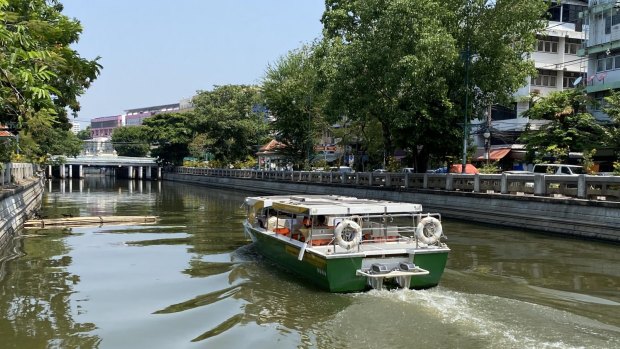
Credit: Inge Holst
Bangkok's river revival is not confined to its art-filled banks. To properly enjoy and understand it, it helps to be out and on it. However, any excitement must be tempered by the fact that the Chao Phraya remains one of the world's most intractably polluted waterways.
In the past fancifully dubbed the "Venice of the East" due to the intricate network of canals or khlongs that run off it like the filthy fingers of a dirty hand, the river's treacly waters were once memorably described by a guidebook as a "liquid coma".
But while we've been away hope has emerged. An electric passenger boat service was introduced as part of a clean energy project instigated by the unelected Prime Minister Prayut Chan-o-cha, who heads Thailand's military government.
The boats run past tree-lined, rehabilitated banks criss-crossed by repainted and restored iron foot and road bridges in the Khlong Phadung Krung Kasem, near the grand old and soon to be decommissioned railway station.
The water, still a slightly off-putting olive green, seems much healthier than Bangkok's other canals, though that wouldn't be hard.
Departing from Hua Lamphong Railway Station Pier, I board one of the seven electric fibreglass boats, each transporting 30 passengers. Each boat is able to run for four hours per charge and travel at a gentle 10 to 15 kilometres an hour. Each is fitted with solar-panelled roofs to help power the motor and lamps.
For now, rides on the boats are free to encourage locals and tourists to try the service. This ain't Venice quite yet, or ever will be, but as token as an environmental measure as it may be, it's an encouraging start.
Bangkok may not be quite the city it used to be, and that may not be such a bad thing, but it's certainly packing a lot more bang for your buck besides its river. How cool is that?
FIVE MORE RIVERSIDE BANGKOK THINGS TO SEE AND DO
HARMONIQUE RESTAURANT
Down a rather anonymous soi, or laneway, off busy Charoen Krung Road in Bang Rak, this tiny diner is at no risk of making the Thai Michelin guide. But it's well worth a visit for its cheap and delectable homestyle cooking as well as for its amazing, partially al fresco, setting which delivers a true taste of Old Bangkok, including ancient banyan trees embedded with Buddhist motifs and Thai memorabilia collected from the owners over many decades. See bangkokriver.com
HORSE UNIT & WOOT WOOT
Just when we thought army disposals stores had been disposed of, along comes Horse Brigade at Warehouse 30. This shop takes it all to another level with its selection of vintage military clothing, army antiques and posters. Upstairs, is the slightly more sober lifestyle store Woot Woot, selling offbeat retro items for the home. Retire with your purchases to the excellent Coffee Roaster by Li-bra-ry, a few doors down from Horse Brigade, which also has a trendy frock shop at the rear. See warehouse30.com
SAMSARA CAFE AND MEAL
Tucked behind a Buddhist temple and a tad beyond the Creative District, Samsara can be difficult to find, even with Google Maps, but it's well worth the effort. This timber-clad Thai-Japanese bar and eatery is perched right on the edge of Chao Phraya's waters, so much so that it can feel like you're in some kind of rickety houseboat. It's a great spot for a cruisy tipple and a treat and there are few better places to watch the river and its myriad vessels float by. No website
PATINA BANGKOK
Talk about a minimalist reno. Slap bang the middle of Talat Noi, Patina is set in a Chinese-style house built during the reign of King Rama I (1737 - 1809) By day Patina operates as a hip cafe; at night it's a bar with live music performed in a courtyard, replete with its own well, linking to a building at the rear which holds exhibitions. When the trio of friends who own and run the cafe-bar first refurbished the house, they were determined to retain as much of its flaking patina, hence the name, as possible. See bangkokriver.com
BANGKOK FOLK MUSEUM
When tourists visit a home-based museum in Bangkok it's invariably the exquisitely-restored and maintained Jim Thompson's House. Far less polished is this antique Thai house that forms the Bangkok Folk Museum, donated to the public by its owner Waraporn Suravadee in 2004. Her classic wooden abode is preserved along with many of her possessions, and there's barely a single pane of glass with a multitude of timber window shutters keeping the inside cool. The two-storey house is set within tropical gardens.
THE DETAILS
STAY
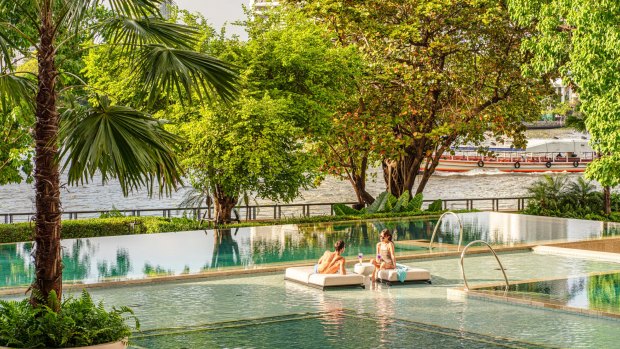
Rooms at Four Seasons Bangkok at Chao Phraya River from THB12,600 ($516) plus taxes a night. 300/1 Charoen Krung Rd, Khwaeng Yan Nawa, Khet Sathon, Bangkok. Ph:+66 2 032 0888. See
FLY
Thai Airways operate regular direct flights to Bangkok's main Suvarnabhumi Airport from Sydney and Melbourne. See thaiairways.com
VISIT
Fully-guided tours of the Creative District and also Kudeejeen, Bangkok's historic Portuguese district, can be reserved directly through the concierge at Four Seasons Bangkok at Chao Phraya River. An excellent resource for any stay beside the Chao Phraya is bangkokriver.com It's an informative guide to the best cultural and culinary sights.
TRANSPORT
For getting around the river, taxis are air-conditioned, safer, plentiful and far cheaper than tuk tuks but arguably not as much fun. The main public ferry, stopping at piers along the Chao Phraya, is a bargain and an enjoyable way to see the city, including Talat Noi and Bang Rak. See chaophrayaexpressboat.com
MORE
Sign up for the Traveller Deals newsletter
Get exclusive travel deals delivered straight to your inbox. Sign up now.